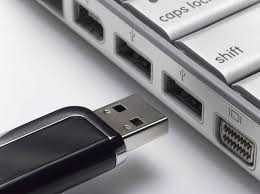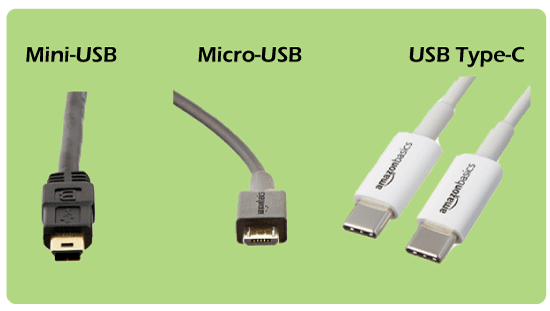What is USB?

A USB is a common computer port, which shorts for Universal Serial Bus and allows communication between a computer and peripheral or other devices. It is the most common interface used in today’s computers, which can be used to connect printers, scanners, keyboards, mice, game controllers, digital cameras, external hard drives and flash drives. The USB has replaced a wide range of interfaces like the parallel and serial port because it is used for a wide variety of uses as well as offers better support for electrical power. With a single USB port, up to 127 peripherals can be connected with the help of a few USB hubs, although that will need quite a bit of dexterity.
A USB is intended to allow hot-swapping and enhance plug-and-play. Without having to restart the computer, plug-and-play makes it capable of operating the system to involuntarily discover and configure, and hot-swapping allows replacement and removal of a new peripheral device. In the devices like smartphones and tablets, a USB may also use for supplying power as well as charge their batteries. Its first version 1.0, was introduced in January 1996. Then, Intel Compaq, Microsoft, and other companies adopted this industry-standard quickly.
There are many types of USB connectors, but type A and type B are one of two major types. Type A is USB 2.0, which contains a flat rectangle interface. And, to supply power and transmit data, it is inserted into a USB or hub host. The input device, keyboard and mouse are a well-known example of type A USB connectors. A type B USB uses a removable cable like a printer and is connected to an upstream port. Some type B connectors are unable to offer data connection, and they are only capable of using as a power connection.
Ajay Bhatt, a computer architect co-invented and established the USB, and he had been working for Intel. Seven companies, NEC Corporation, Nortel, Intel, Compaq, Digital Equipment Corporation (DEC), IBM and Microsoft, began to develop the USB in 1994. The main objective of these companies was to eliminate a large number of connectors and make it easier to connect peripheral devices to a computer. It involved factors, which are
- It creates large bandwidths and stream configurations.
- For current interfaces, it solves utilization problems.
USBIF is a USB Implementers Forum that standardized the USB design. It includes a wide number of companies promoting and supporting the USB. The USBIF is not only about the USB design but also upholds the compliance program and maintains the specifications. With the 2.0 version, specifications were created for the USB in 2005. In 2001, USBIF introduced the standards in which the earlier versions 0.9, 1.0 and 1.1 were included that are backward compatible. Generally, it is designed for hot swapping, higher quality cabling, easy installation and faster transfer rates. The bulkier, parallel and serial port conclusively have been replaced by USB.
Hot swapping is one of the best benefits of USB, which allows a device to be removed from the system without the need of rebooting the system. Because older ports needed that a PC be reboot while adding or removing a new device with them. By rebooting the system, the device will be reconfigured and can prevent electrostatic discharge. Sensitive electronic equipment like integrated circuits can be seriously damaged through an unwanted electrical current. Despite a hardware failure, hot-swapping has the ability to continuously operate because it is fault-tolerant. However, there are some devices, such as a camera, that need care when hot-swapping these devices. Because the port, camera or other devices can be damaged if a single pin is accidently shorted.
USB version 1 offers two types of speed that work best for slow I/O devices: the speeds are 1.5 Mb per second and 12 Mb per second. With slower USB devices, USB version 2 is backward compatible and offers up to 480 Mb/s.
List of USB devices
In modern times, to connect with the computer, there are many different USB devices. Some common are as follows:
- Keyboard
- Smartphone
- Tablet
- Webcams
- Keypad
- Microphone
- Mouse
- Joystick
- Jumpdrive aka Thumb drive
- Scanner
- Printer
- External drive
- iPod or other MP3 players
- Digital Camera
Where are the USB ports?
In modern times, all computers contain at least one USB port in different locations. Below, a list is given that contains USB port locations on the devices that may help you out to find them.
Laptop computer: A laptop computer may contain one to four ports on the left or right side, and some laptops have on the behind of the laptop computer.
Desktop computer: Usually, a desktop computer has 2 to 4 USB ports in the front and 2 to 8 ports on the backside.
Tablet computer: On the tablet, a USB connection is situated in the charging port and is sometimes USB-C and usually micro USB.
Smartphone: In the form of micro USB or USB-C, a USB port is used for both data transfer and charging, similar to tablets on smartphones.
USB connector types
There are different shapes and sizes available for the USB connector. Also, there are numerous versions of USB connectors, such as Mini USB, Micro USB, etc.

- Mini -USB: Mini USB is used with digital cameras and computer peripherals and divided into A-type, B-type and AB-type. It is also known as mini-B and is the most common type of interface. On the latest devices, Micro-USB and USB-C cables have largely replaced the mini-USB. It transfers data and power between two devices as it is made of coaxial cable. Also, it is applied to MP3 players, digital cameras, and mobile hard drives. In a mini USB cable, one-end is a much smaller quadrilateral hub, and the other end is a standard flat-head USB hub. Thus, it is easily plugged into mobile devices. The mini USB can also be used to transfer data between computers with at least one USB port but is mainly used for charging devices. It includes two advantages: Waterproofness and Portability.
- Micro-USB: It is a reduced version of the USB (Universal Serial Bus). It was announced in 2007 and designed to replace mini-USB and developed for connecting compact and mobile devices such as digital cameras, smartphones, GPS devices, Mp3 players and photo printers.
Micro A, micro B and micro USB 3 are the three varieties of Micro-USB. The type Micro-A and Micro-B have a connector size of 6.85 x 1.8 mm, although the Micro-A connector has a greater maximum overmild size. USB 3 micro is more similar to micro B, but it has better speed as compared to micro B because it includes an additional collection of pins on the side for twice the wires. Micro versions are hot-swappable, and plug-and-play like standard USB and micro-USB is still widely used with electronic devices. - USB Type-C: On most modern newer Android smartphones and other USB-connected devices, a USB Type-C cable is a relatively new type of connector. It is used for delivering data and power to computing devices. As compared to other forms of USB connections, USB-C cables are reversible; they can be plugged either way in the devices, whether they are upside down.
USB transfer speeds
- USB 1.0 is capable of supporting up to 127 peripheral devices and also able to support data transfer rates of 12 Mbps as it is an external bus standard.
- In 2001, USB 2.0 was developed by Phillips, Lucent, Microsoft, Hewlett Packard, Intel, NEC, and Compaq that is also known as hi-speed USB. It has the ability to support a transfer rate of 60 megabytes per second or up to 480 Mbps (megabits per second).
- In November 2009, USB 3.0 was available for the first time by Buffalo Technology, which is also called as SuperSpeed USB. But until January 2010, the first certified devices were not available. The performance and increased speed in USB 3.0, also helped to improve upon the USB 2.0 technology, power management and increased bandwidth capability.
It includes a feature to offer two unidirectional data paths to send and receive data in one go. It can support transfer rates of 640 megabytes per second, or up to 5.0 gigabits per second (Gbps). Its name was changed to USB 3.1 Gen1 for making purposes after releasing the USB 3.1. The first certified devices were designed with motherboards of Gigabyte and ASUS Technology. In April 2011, Dell started to introduce USB 3.0 ports with their Dell XPS and Inspiron series of computers. - USB 3.1 is the latest version of the USB protocol that was made available till 31 July 2013, which is also known as SuperSpeed It can support transfer rates of up to 10 Gbps. Nowadays, USB 3.0 and 3.1 revisions are used by various devices to improve speed and performance.
USB version compatibility
Every version of the USB port can support any version of USB (Universal Serial Bus), as it has the ability to compatible with both backward and forward. For example, devices are able to work in a 3.0 designing with USB 1.1 and 2.0 technology. Even though USB 3.0 is capable of higher speed, devices with lower versions run at their native transfer speed. Therefore, if a USB 3.1 device is connected with a USB 2.0 port, its max transfer rate is limited to that of the 2.0 port.
History of USB
| Year | Event |
|---|---|
| 1994 | The USB first version of USB 0.8 was released in December 1994. But it was not available in the market and considered as a pre-release version. |
| 1995 | In April 1995, USB 0.9 was released. Like USB 0.8, it was not available commercially and a pre-release version. In August 1995, another version of USB was also released as a USB 0.99. |
| 1996 | In January 1996, the first commercial version of USB 1.0, was introduced that was released with the data transfer rate of 12 Mbps. |
| 1998 | The next version, USB 1.1, was much better, which was introduced in August 1998. With the release of USB 1.1, various USB devices were sold. In the same year, 1998, the first computer to have only USB ports, Apple iMac G3, was released. But it had no parallel ports and serial ports for external device connectivity. |
| 2000 | In April 2000, to have a data transfer rate of up to 480 Mbps, USB 2.0 was released. However, maximum data transfer rates of bus limitations were up to 280 Mbps. |
| 2008 | The next version of USB 3.0 was introduced with data transfer rates up to 5 Gbps on 12 November 2008. |
| 2013 | In July 2013, the next version USB 3.1 was released that offered data transfer rates up to 10 Gbps. |
| 2017 | In September 2017, providing data transfer rates up to 20 Gbps USB 3.2 was released. It introduced the USB-C connector. |
